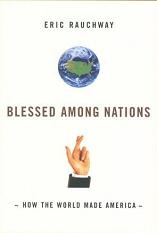
Blessed Among Nations
Eric Rauchway
240 pages including index
published in 2006
The main reason I picked up this book from the Amsterdam library was because I recognised Eric Rauchway’s name; a quick google confirmed that this was the same Eric Rauchway who writes on The Edge of the American West, an excellent history orientated groupblog. It’s always nice to see somebody who can write clever blogposts is able to sustain that cleverness over the length of a book, as Rauchway did here. It’s even better if it’s done in a book I actually would want to read anyway, of course.
Blessed Among Nations is an examination of “American exceptionalism”, the idea that America as a country is different from other countries in more than the trivial way in which every country differs from every other country. In several ways the United States differ from its peers in Western Europe. It is the largest economy in the world, but depends on investment of foreign labor and capital to keep its economy running. It spent much less on social welfare than other rich countries, its government is somewhat less centralised as well and finally there has never been the kind of broad mass socialist or social democrat movement in the US as there has been in Europe. What Rauchway wants to do in his book is to explain these differences without either explaining them away or falling in the trap that America is special, unbound by rules that govern lesser nations.
The explenation Rauchway reaches is contained in the subtitle of the book: How the World Made America. He argues that the foundation for modern post-world war America was laid in the period between the Civil War and World War I, during the first era of globalisation. During this era America was a favourite destination of both labour and capital, the first in the shape of mass immigration from Europe, the second through investments made by British investers. America was far away enough from Europe not to be sucked into the great power conflicts there but near enough through new technology like the telegraph and the steamship to be integrated in the worldwide capitalist system. What’s more, America could make do with a relatively small army and navy as it could shelter behind the might of the Royal Navy as Britain kept the oceans free for their own purposes, while its expension westwards brought the country into conflict with mainly military inferior opponents.



